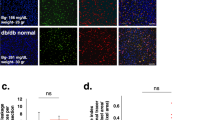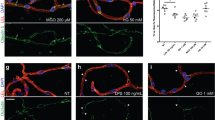Abstract
Both type-1 and type-2 DM are related to an increased risk of cognitive impairment, neurovascular complications, and dementia. The primary triggers for complications are hyperglycemia and concomitant insulin resistance in type-2 DM. However, the diverse mechanisms in the pathogenesis of diabetes-related neurovascular complications and extracellular matrix (ECM) remodeling in type-1 and 2 have not been elucidated yet. Here, we investigated the high fat-high sucrose (HFHS) feeding model and streptozotocin-induced type-1 DM model to study the early effects of hyperglycemia with or without insulin resistance to demonstrate the brain microcirculatory changes, perivascular ECM alterations in histological sections and 3D-reconstructed cleared brain tissues. One of the main findings of this study was robust rarefaction in brain microvessels in both models. Interestingly, the HFHS model leads to widespread non-functional angiogenesis, but the type-1 DM model predominantly in the rostral brain. Rarefaction was accompanied by basement membrane thickening and perivascular collagen accumulation in type-1 DM; more severe blood-brain barrier leakage, and disruption of perivascular ECM organization, mainly of elastin and collagen fibers’ structural integrity in the HFHS model. Our results point out that the downstream mechanisms of the long-term vascular complications of hyperglycemia models are structurally distinctive and may have implications for appropriate treatment options.






Similar content being viewed by others
Data availability
The data that support the findings of this study are available on request from the corresponding author.
References
Blaise S et al (2013) Elastin-derived peptides are new regulators of insulin resistance development in mice. Diabetes 62(11):3807–3816. https://doi.org/10.2337/db13-0508
Brands AMA et al (2005) The effects of type 1 diabetes on cognitive performance: a meta-analysis. Diabetes Care, United States 28(3):726–735. https://doi.org/10.2337/diacare.28.3.726
Corem N et al (2019) Leptin receptor deficiency induces early, transient and hyperglycaemia-independent blood-brain barrier dysfunction. Sci Rep 9(1):2884. https://doi.org/10.1038/s41598-019-39230-1
Crane PK et al (2013) Glucose levels and risk of dementia. N Engl J Med 369(6):540–548. https://doi.org/10.1056/NEJMoa1215740
Di Marco E et al (2015) Are reactive oxygen species still the basis for diabetic complications? Clin Sci (London, England: 1979) England 129(2):199–216. https://doi.org/10.1042/CS20150093
Ertürk A et al (2012) Three-dimensional imaging of solvent-cleared organs using 3DISCO. Nat Protoc Engl 7(11):1983–1995. https://doi.org/10.1038/nprot.2012.119
Geraldes P et al (2009) Activation of PKC-delta and SHP-1 by hyperglycemia causes vascular cell apoptosis and diabetic retinopathy. Nat Med 15(11):1298–1306. https://doi.org/10.1038/nm.2052
Hughes RN (2004) The value of spontaneous alternation behavior (SAB) as a test of retention in pharmacological investigations of memory. Neurosci Biobehav Rev, United States 28(5):497–505. https://doi.org/10.1016/j.neubiorev.2004.06.006
King AJF (2012) The use of animal models in diabetes research. Br J Pharmacol 166(3):877–894. https://doi.org/10.1111/j.1476-5381.2012.01911.x
Kubíková T et al (2018) Numerical and length densities of microvessels in the human brain: Correlation with preferential orientation of microvessels in the cerebral cortex, subcortical grey matter and white matter, pons and cerebellum. J Chem Neuroanat, Netherlands 88:22–32. https://doi.org/10.1016/j.jchemneu.2017.11.005
Leger M et al (2013) Object recognition test in mice. Nat Protoc Engl 8(12):2531–2537. https://doi.org/10.1038/nprot.2013.155
Liu Y et al (2021) Three-dimensional remodeling of functional cerebrovascular architecture and gliovascular unit in leptin receptor-deficient mice. J Cereb Blood Flow Metab 41(7):1547–1562. https://doi.org/10.1177/0271678X211006596
Lu P et al (2011) Extracellular matrix degradation and remodeling in development and disease. Cold Spring Harb Perspect Biol 3(12). https://doi.org/10.1101/cshperspect.a005058
Lyoo IK et al (2012) Prefrontal cortical deficits in type 1 diabetes mellitus: brain correlates of comorbid depression. Arch Gen Psychiatry 69(12):1267–1276. https://doi.org/10.1001/archgenpsychiatry.2012.543
Ma Y et al (2020) Higher risk of dementia in English older individuals who are overweight or obese. Int J Epidemiol 49(4):1353–1365. https://doi.org/10.1093/ije/dyaa099
McDonald TO et al (2007) Diabetes and arterial extracellular matrix changes in a porcine model of atherosclerosis. J Histochem Cytochem 55(11):1149–1157. https://doi.org/10.1369/jhc.7A7221.2007
Nicoloff G et al (2000) Relationship between elastin-derived peptides and the development of microvascular complications: a longitudinal study in children with Type 1 (insulin-dependent) diabetes mellitus. Gen Pharmacol Engl 35(2):59–64. https://doi.org/10.1016/s0306-3623(01)00088-x
Özkan E et al (2021) Blood-brain barrier leakage and perivascular collagen accumulation precede microvessel rarefaction and memory impairment in a chronic hypertension animal model. Metab Brain Dis, United States. https://doi.org/10.1007/s11011-021-00767-8
Papatheodorou K et al (2018) Complications of diabetes 2017. J Diabetes Res 3086167. https://doi.org/10.1155/2018/3086167
Prakash R et al (2012) Enhanced cerebral but not peripheral angiogenesis in the Goto-Kakizaki model of type 2 diabetes involves VEGF and peroxynitrite signaling. Diabetes 61(6):1533–1542. https://doi.org/10.2337/db11-1528
Prakash R et al (2013) Cerebral neovascularization and remodeling patterns in two different models of type 2 diabetes. PLoS ONE 8(2):e56264. https://doi.org/10.1371/journal.pone.0056264
Price TO et al (2012) Topiramate treatment protects blood-brain barrier pericytes from hyperglycemia-induced oxidative damage in diabetic mice. Endocrinology 153(1):362–372. https://doi.org/10.1210/en.2011-1638
Rom S et al (2019) Hyperglycemia-driven neuroinflammation compromises BBB leading to memory loss in both Diabetes Mellitus (DM) type 1 and type 2 mouse models. Mol Neurobiol 56(3):1883–1896. https://doi.org/10.1007/s12035-018-1195-5
Rust R et al (2020) A practical guide to the automated analysis of vascular growth, maturation and injury in the brain. Front NeuroSci 14:244. https://doi.org/10.3389/fnins.2020.00244
Salameh TS et al (2016) Blood-brain barrier disruption and neurovascular unit dysfunction in diabetic mice: protection with the mitochondrial carbonic anhydrase inhibitor topiramate. J Pharmacol Exp Ther 359(3):452–459. https://doi.org/10.1124/jpet.116.237057
Salameh TS et al (2019) Disruption of the hippocampal and hypothalamic blood-brain barrier in a diet-induced obese model of type II diabetes: prevention and treatment by the mitochondrial carbonic anhydrase inhibitor, topiramate. Fluids Barriers CNS 16(1):1. https://doi.org/10.1186/s12987-018-0121-6
Seibenhener ML, Wooten MC (2015) Use of the Open Field Maze to measure locomotor and anxiety-like behavior in mice. J Vis Exp: JoVE 96e52434. https://doi.org/10.3791/52434
Smolina K, Wotton CJ, Goldacre MJ (2015) Risk of dementia in patients hospitalised with type 1 and type 2 diabetes in England, 1998–2011: a retrospective national record linkage cohort study. Diabetologia 58(5):942–950. https://doi.org/10.1007/s00125-015-3515-x
Stauber WT, Ong SH, McCuskey RS (1981) Selective extravascular escape of albumin into the cerebral cortex of the diabetic rat. Diabetes United States 30(6):500–503. https://doi.org/10.2337/diab.30.6.500
Stranahan AM et al (2016) Blood-brain barrier breakdown promotes macrophage infiltration and cognitive impairment in leptin receptor-deficient mice. J Cereb Blood Flow Metab 36(12):2108–2121. https://doi.org/10.1177/0271678X16642233
van Harten B et al (2006) Brain imaging in patients with diabetes: a systematic review. Diabetes care United States 29(11):2539–2548. https://doi.org/10.2337/dc06-1637
Wang SY et al (2017) Incidence and risk factors for developing diabetic retinopathy among youths with type 1 or type 2 diabetes throughout the United States. Ophthalmology 124(4):424–430. https://doi.org/10.1016/j.ophtha.2016.10.031
Wang Y et al (2022) Cognitive impairments in type 1 diabetes mellitus model mice are associated with synaptic protein disorders. Neurosci Lett Irel 777:136587. https://doi.org/10.1016/j.neulet.2022.136587
Wessels AM et al (2006) Microvascular disease in type 1 diabetes alters brain activation: a functional magnetic resonance imaging study. Diabetes United States 55(2):334–340. https://doi.org/10.2337/diabetes.55.02.06.db05-0680
Whitmer RA et al (2009) Hypoglycemic episodes and risk of dementia in older patients with type 2 diabetes mellitus. JAMA 301(15):1565–1572. https://doi.org/10.1001/jama.2009.460
Wild S et al (2004) Global prevalence of diabetes: estimates for the year 2000 and projections for 2030. Diabetes Care, United States 27(5):1047–1053. https://doi.org/10.2337/diacare.27.5.1047
Xue M et al (2019) Diabetes mellitus and risks of cognitive impairment and dementia: A systematic review and meta-analysis of 144 prospective studies. Ageing Res Rev. Engl 55:100944. https://doi.org/10.1016/j.arr.2019.100944
Zudaire E et al (2011) A computational tool for quantitative analysis of vascular networks. PLoS ONE 6(11):e27385. https://doi.org/10.1371/journal.pone.0027385
Acknowledgements
The authors gratefully acknowledge the use of the services and facilities of the Koç University Research Center for Translational Medicine (KUTTAM), funded by the Republic of Turkey’s Ministry of Development. The content is solely the authors’ responsibility and does not necessarily represent the official views of the Ministry of Development. E.Ö. is the guarantor of this work and, as such, had full access to all the data in the study and takes responsibility for the integrity of the data and the accuracy of the data analysis.
Funding
This research is funded by Koç University – Seed Fund (SF.00051) of Prof. Yasemin Gürsoy Özdemir.
Author information
Authors and Affiliations
Contributions
EÖ and YCT designed and performed all experiments, analyzed data, and wrote the manuscript. ESK, BY, NS, SS, CÖ, JK, ABK, and MP performed experiments and contributed to manuscript editing. HYE, SK, and MZ contributed to the study design and supervision process. YGÖ initiated and supervised the study, provided financial support, and revised the manuscript. All authors read and approved the final version of the manuscript.
Corresponding author
Ethics declarations
Ethical approval
All experiments and procedures were applied according to the protocols and criterions approved by the Institutional Animal Care and Use Committee (IACUC) of Koç University with approval number 2015.HADYEK.003/009, according to Directive 2010/63/EU of the European Parliament and the Council on the Protection of Animals Used for Scientific Purposes. All experiments were reported in compliance with the Animal Research: Reporting in Vivo Experiments (ARRIVE) guidelines.
Prior presentation
The data presented here has not been published elsewhere.
Conflict of interest
The authors declare no conflict of interest.
Additional information
Publisher’s note
Springer Nature remains neutral with regard to jurisdictional claims in published maps and institutional affiliations.
Supplementary Information
Below is the link to the electronic supplementary material.
ESM 1
(DOCX 669 KB)
Rights and permissions
Springer Nature or its licensor (e.g. a society or other partner) holds exclusive rights to this article under a publishing agreement with the author(s) or other rightsholder(s); author self-archiving of the accepted manuscript version of this article is solely governed by the terms of such publishing agreement and applicable law.
About this article
Cite this article
Özkan, E., Çetin-Taş, Y., Şekerdağ, E. et al. Hyperglycemia with or without insulin resistance triggers different structural changes in brain microcirculation and perivascular matrix. Metab Brain Dis 38, 307–321 (2023). https://doi.org/10.1007/s11011-022-01100-7
Received:
Accepted:
Published:
Issue Date:
DOI: https://doi.org/10.1007/s11011-022-01100-7




